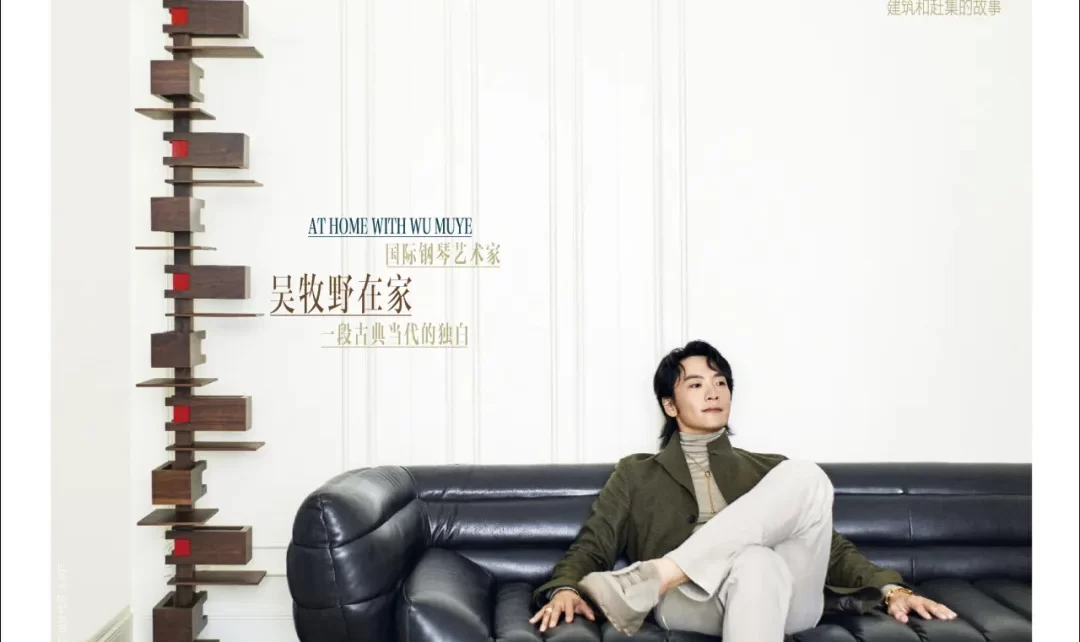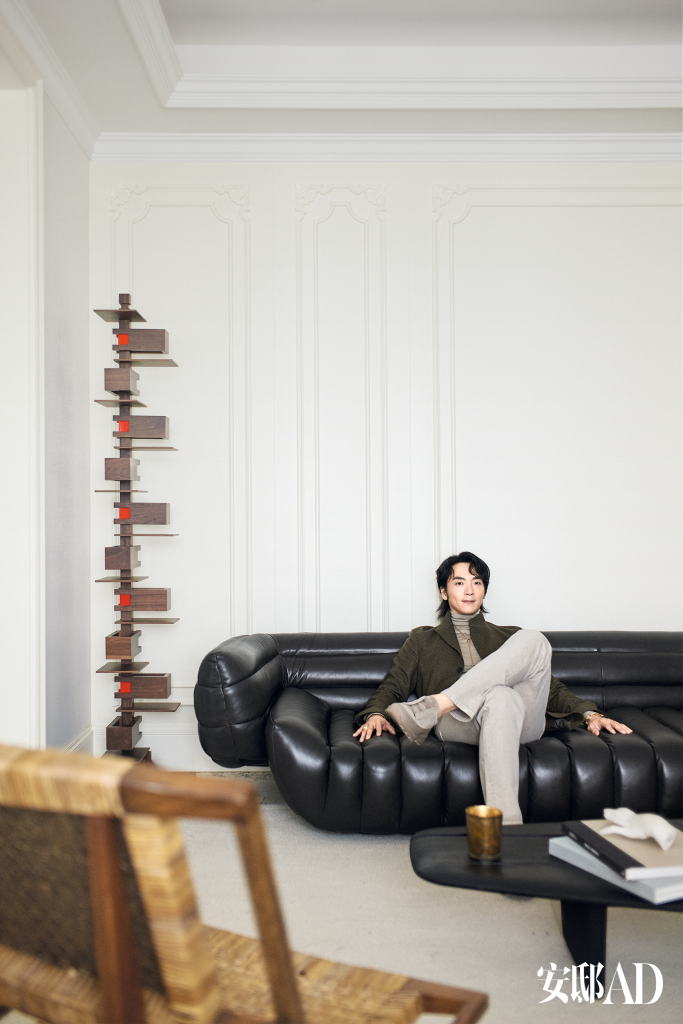
Under the night sky, the West Lake shimmers like a mirror as he arrives in a boat. With his fingers, he breaks the moonlight into a hundred melodies, flowing into Debussy’s Clair de Lune. Within the fleeting, floral notes carries a dream of peaceful times. This scene from the cultural performance at the 2016 Hangzhou G20 Summit leaves a lasting impression on many, marking the beginning of Muye Wu’s connection with Hangzhou, where he eventually makes his home.
Chapter One: The Prince’s “Green”
He has a passion for furniture with strong contrasts. He mentions how the design of this black sofa reminds him of piano keys, and the black oak coffee table gives him the feeling of lightning striking. The handcrafted bamboo lounge chair is from YIJI COLLECTION, the black oak coffee table and yellow marble coffee table are from Baxter, the beige rug and hand-shaped marble ornament are from B&B Italia, and the black wooden pipe sculpture is from Molteni&C. Books and aromatherapy are from For.D. The green landscape Cloud Forest Communities of the Colombian Andes is a work by botanical artist Huang Shuo. The Art Deco beechwood cello cabinet and the 20th-century lacquer-painted carved six-panel screen are from AMBELIE. Muye Wu wears an olive-green Piaget jacket, a turtleneck sweater, gray jeans, and camel-colored casual shoes, all from Ermenegildo Zegna.
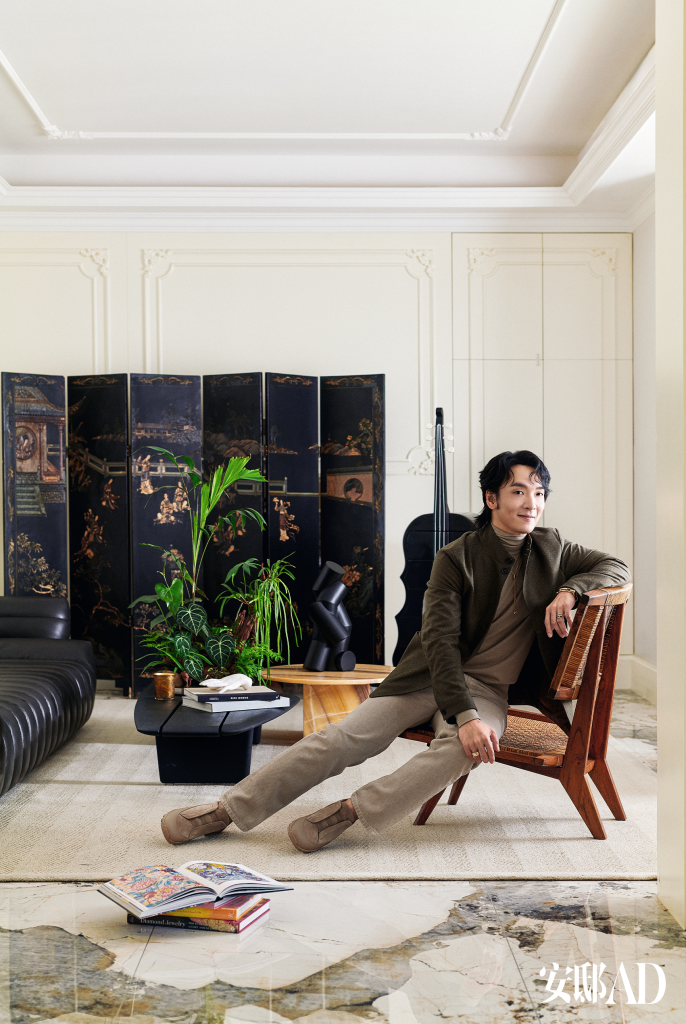
Naturally, the piano is the centerpiece of his home. Muye Wu says he practices every day, usually in the morning after walking his dog in the nearby mountains. The 19th-century Swiss Auguste Maximilien Delafontaine gilded bronze candelabra is from AMBELIE. The handcrafted bamboo lounge chair is from YIJI COLLECTION. The black sideboard is from MOOOI, available through For.D. The black grand piano is from Kayserburg.
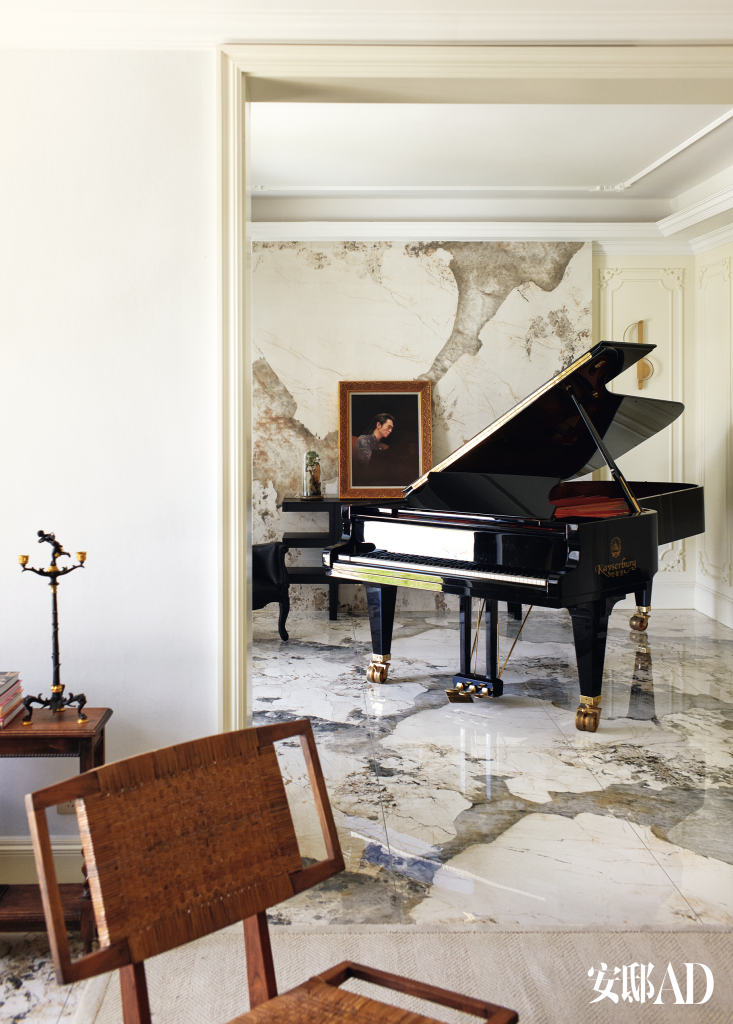
Although labeling him the “Piano Prince” might seem cliché, if this term encapsulates technique, style, and looks, then Muye Wu certainly personifies it. The Prince remains captivated by the West Lake’s moonlit night: “That blue, with a hint of green, blended with moonlight—that’s the memory Hangzhou left me, a distinctly Chinese, Jiangnan hue of green.” Today, Muye Wu lives just outside Hangzhou, a place surrounded by nature, which he considers his paradise.
Colors seem to be his way of remembering things. His childhood in Hainan is filtered through an orange-yellow lens, and Beijing with a blend of blue and earth tones. The time he spent studying in Paris evokes a literal “golden age,” one of opulence and intricate beauty: “That is Europe.” If everyone has their own memory triggers, Muye Wu’s are abstract yet precise, much like art.
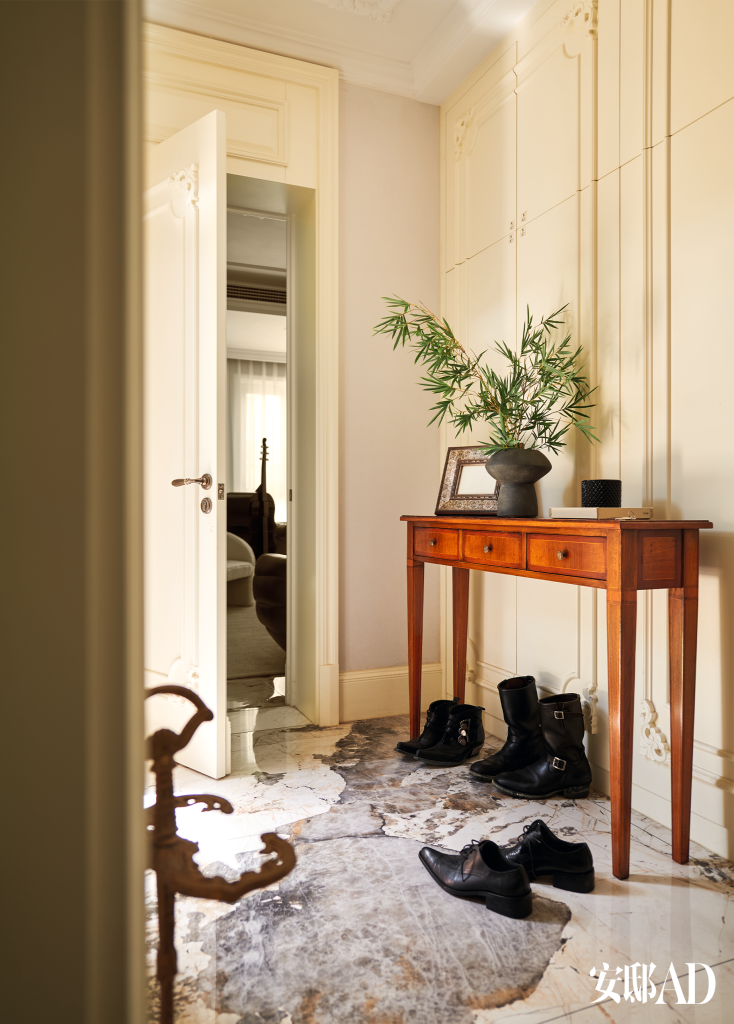
The Art Deco rosewood foyer table with fine wood inlay and vintage photo frame are from AMBELIE. The gray vase is from Baxter, and the black aromatic candles are from For.D.
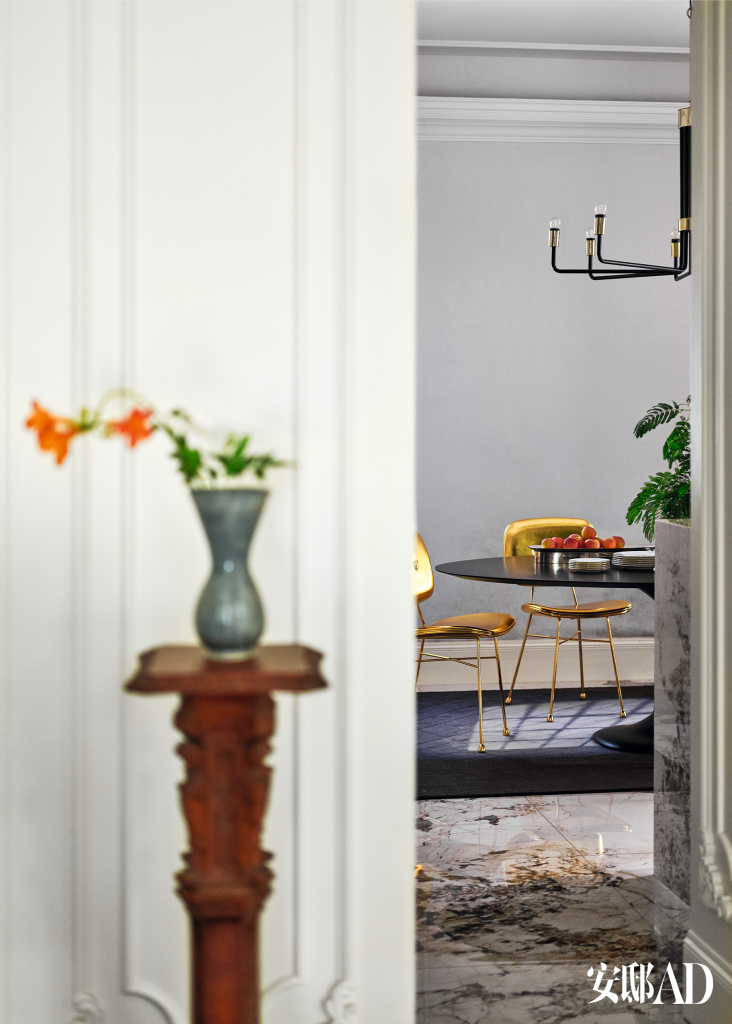
The living room is connected to the kitchen and dining area, which features a late 19th-century Roman decorative column from Rome, and an antique wide-mouth porcelain vase from Japan, both from AMBELIE. The black oval dining table, black shadow-patterned rug, and gold dining chairs are all from Moooi, sourced from For.D. The black chandelier is from YIJI COLLECTION.
“The things that stick in my memory seem to be the light, colors, smells, and even the humidity in the air of each place.” Born into a musical family, Muye Wu’s childhood and teenage years mirrored that of many musical prodigies—structured and busy with little free time. Yet, he vividly recalls fleeting moments: the taste of food from street stalls near the Central Conservatory of Music, the indescribable scent under a bridge he passed daily, and the thrill of first arriving in Paris—sensitive at 13 or 14, when he suddenly “saw the light!” Musicians are perhaps born to be sensitive masters, perceiving light in layers, forming natural color palettes, and experiencing emotions down to every second. This sensitivity is both their greatest joy and deepest torment.

Muye Wu reflects, “To enter music, you must learn to let go early.” Music is about creation, which requires deep contemplation and time, yet we must never forget what first moved us when we began.
So, Muye Wu’s description of his day at home varies by season and weather. He decides to start with winter because that’s the season he was born in: “In winter, I take my time getting out of bed. First, I light the fireplace, then prepare breakfast.” Afterward, he takes short breaks in different corners of the house, followed by an hour of walking his dog, morning and evening—something he insists on doing himself. “When I return, my body feels loosened up, and it’s the perfect time to start on the piano.” In spring, there’s often rain, so he tends to wake up earlier. The clear, delicate daylight is what he enjoys most during this “green time.”
Though this sounds like a rich routine, most of the time he’s still alone in the living room with his piano. There are also the pieces of furniture he loves: classic European furniture, Chinese lacquer screens, an armchair with upholstery reminiscent of his dog’s fur, and a jet-black modern sofa that supports him, reminding him of piano keys. “Each has its own personality.” To him, personality means internal contrast. As for home, it has to be a place that holds everything he loves, “where a feeling can be created, sustained, and preserved,” like a giant vacuum bubble where he immerses himself in music, catching inspiration. “This brings me immense joy,” he says while correcting our understanding of joy. To him, capturing inspiration is not just about beauty; it requires the dramatic tension between darkness and light within. “When I sit in each corner of my home, I become different characters in my mind.”
Most of the time
he’s still alone in the living room with his piano.
There are also the pieces of furniture he loves:
Classic European furniture, Chinese lacquer screens,
an armchair with upholstery reminiscent of his dog’s fur,
and a jet-black modern sofa that supports him,
reminding him of piano keys.
Chapter Two: Confessions in Extreme Tension
Muye Wu says the place he spends the most time in his home is still the living room. The walnut-colored TALIESIN2 lamp from the Fallingwater House collection is from AMBELIE; the black oak coffee table is from Baxter, and the leather three-seater sofa is from Baxter from For.D.

Local botanical artist Huang Shuo, who lives nearby, specially designed several plant installations for Muye Wu’s home. One such piece, Cloud Forest Communities of the Colombian Andes, was created after the artist’s travels and experiences in the region.
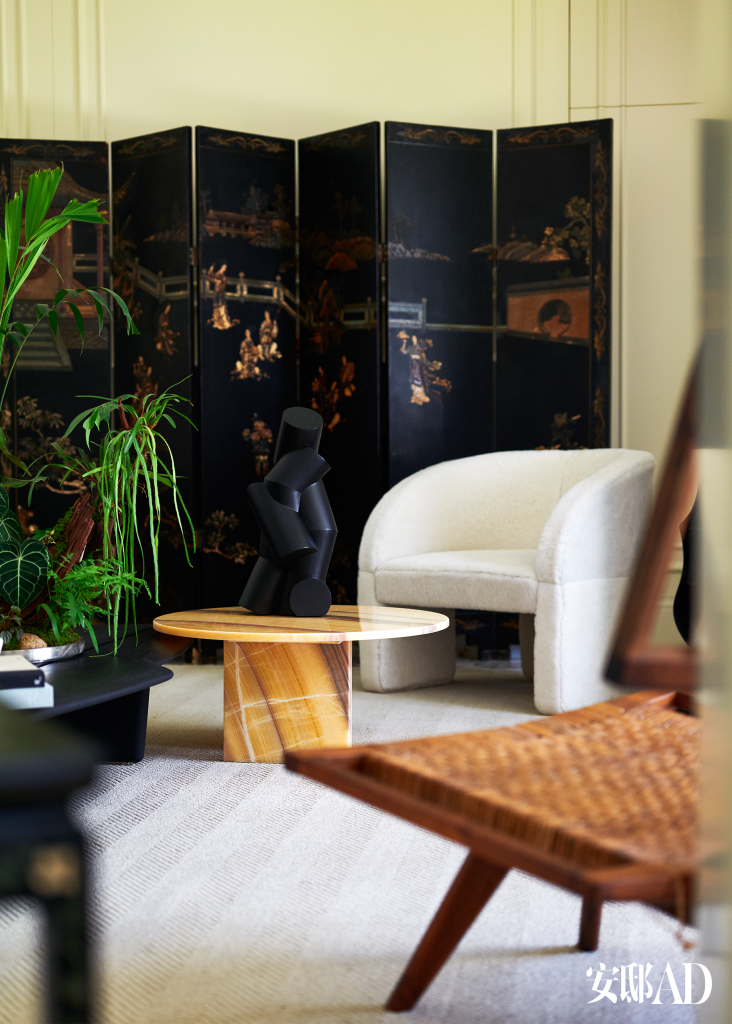
At times, he is a ferocious demon, then a knight braving hell, and at other times, a fairy praising the Virgin Mary. He moves seamlessly between human, hell, and purgatory, his fingers creating shadows over the piano keys with a technique that seems inhuman. Like that Christmas Eve over a hundred years ago when Liszt read The Divine Comedy, Muye Wu amid the verdant mountains of Hangzhou, also completed his own reflections on Dante’s work in a similarly quiet manner. Liszt, the legendary piano master, is Muye Wu’s true mentor, and the focal point of his album Soliloquy of Strength 2, where Muye Wu devoted himself to interpreting Liszt’s work. Known as the Piano King, Liszt, with his notoriously cruel difficulty level, has haunted countless pianists, and Dante Sonata is the ultimate nightmare. But when one rises to the challenge, completes, and conquers it, with the sheer force that shakes the audience to their core—wouldn’t that bring satisfaction, just as Muye Wu felt when he famously broke piano strings during a solo concert at the National Centre for the Performing Arts?
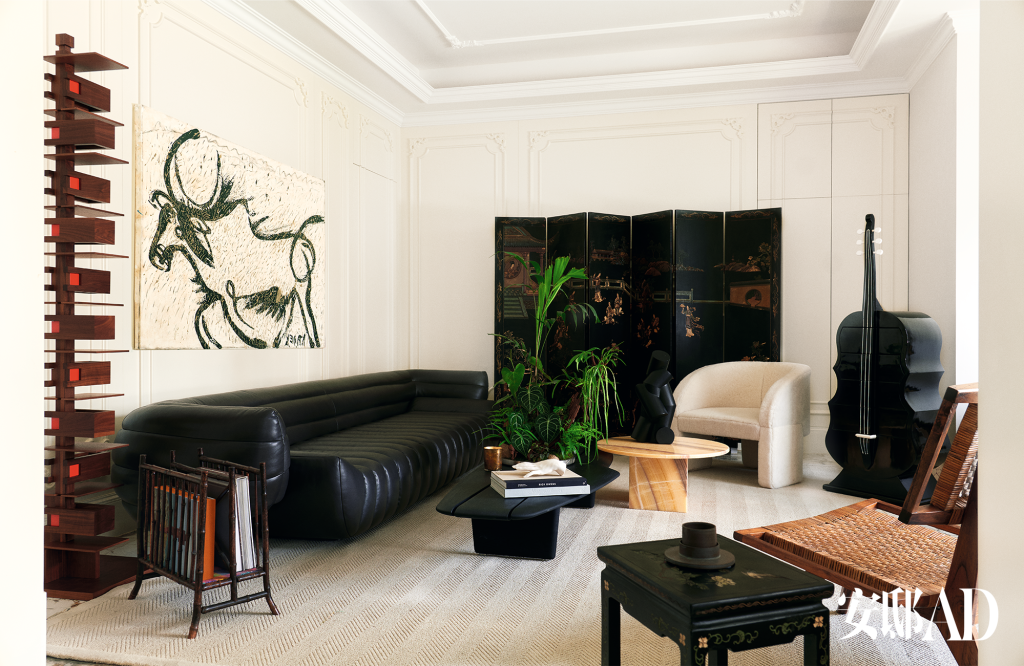
Muye Wu has a clear perception of the four seasons, and his activities at home vary accordingly. The dark ceramic tableware is from Molteni&C; the white wool lounge chair is from Baxter from For.D. The 20th-century painted wooden side table with floral and bird motifs, the antique bamboo magazine rack, and the Art Deco beech wood cello cabinet are from AMBELIE. The hand-painted charcoal and acrylic bullfighting artwork is by artist Kader Boly from YIJI COLLECTION.
“Listeners all say he is showing off his technical skills, but only the performer knows that at that precise moment, only when his fingers reach such speed can the musical image he wants appear: raging storms, sand flying, stones scattering, hell descending…” For them, this is a necessary means to achieve artistic effect because they are destined to connect all thoughts and fantasies through art. However, unlike Liszt’s extreme, free-spirited Bohemian romanticism, this Chinese Prince believes in rationality and control. He never resorts to exaggerated facial expressions while performing.
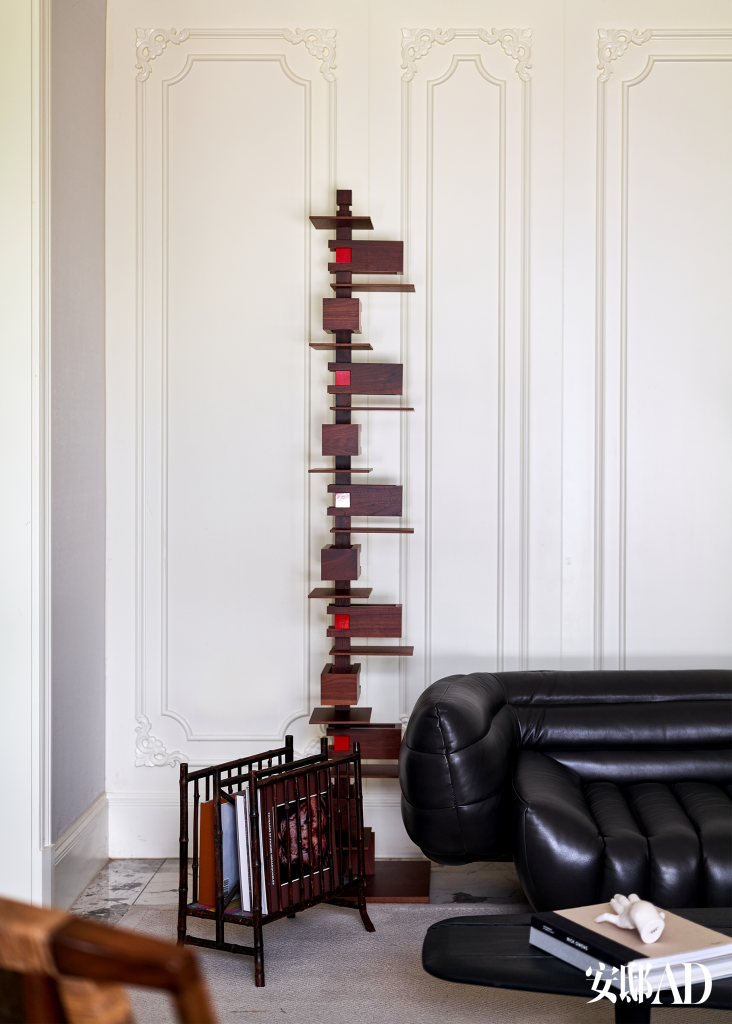
The TALIESIN2 walnut-colored lamp, produced by Yamagiwa, and designed by American modernist architect Frank Lloyd Wright in 1933, is one of the focal points of the living room.
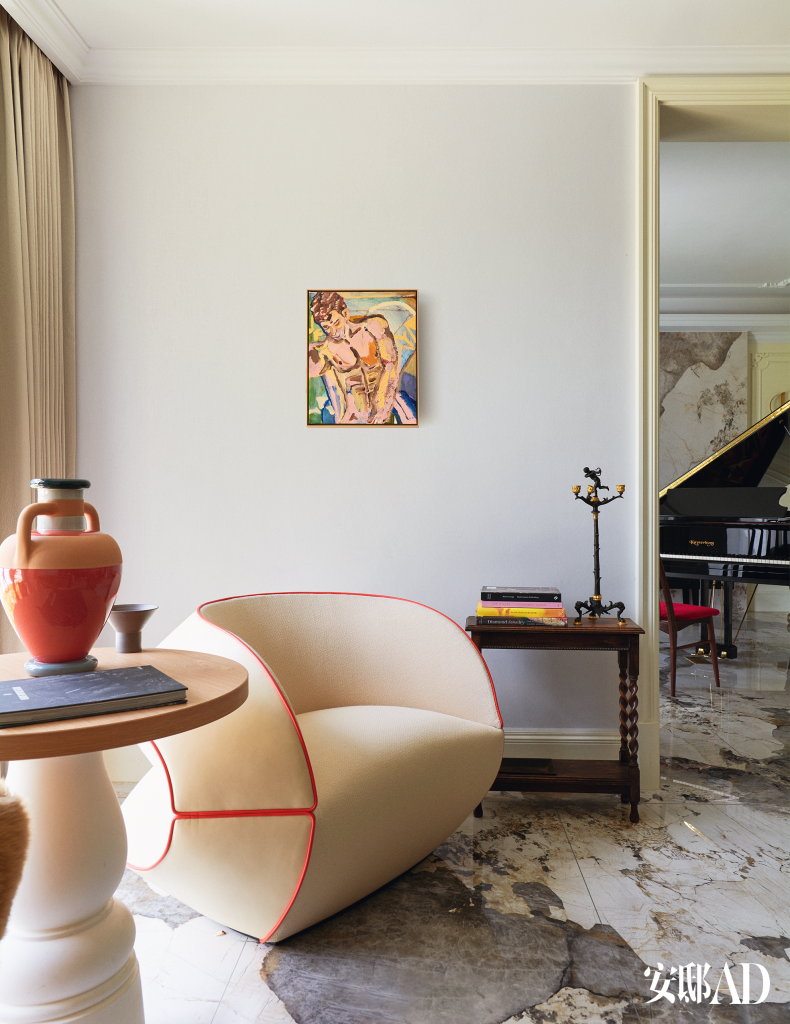
The orange classical vase is from Poltrona Frau, the small side table from MOOOI from For.D; the BINDA orange-edged armchair designed by RAW EDGES for Louis Vuitton’s Objects Nomades collection; the 20th-century British antique umbrella and boot rack from AMBELIE; and the painting on the wall, How Have You Been Lately? by artist Luong Thai, from YIJI COLLECTION.
“Rationality ultimately accumulates into mathematics, and mathematics, in the end, becomes philosophy.” So even though he entered the Paris Conservatoire as the top student and studied under Liszt’s direct descendant, Jacques Rouvier, Muye Wu never gave up his efforts to find self-understanding and expression through books, research, logic, and practice. “Understanding each musician for me is like reading a book,” and whenever he performs their works, he naturally assumes a dual role as both the audience and the musician. Who are they? What were they thinking? What were they feeling at the time? Within the span of a piece of music, the musician has already transformed into countless incarnations, and the performer must summon, follow, and feel them. “But you must also understand your own place within it. I can’t become them, can’t get lost in it, otherwise, it becomes chaotic, and I would merely become a victim.”
His world always has two distinct sides.
He can convey the stormy winds in Liszt’s compositions,
and also the tears in Chopin’s melodies.
Yet at home, Muye Wu leaves room for comfort and ease—
“When I sit in each corner of my home,
I want to become different characters in my mind.”
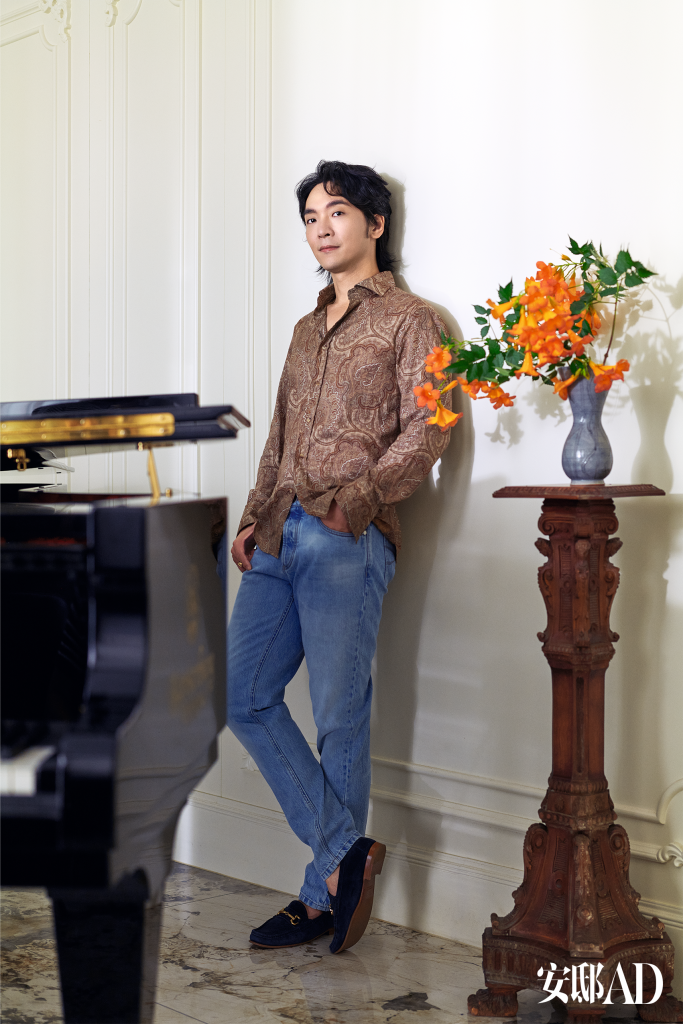
Muye Wu is dressed in a brown shirt, washed jeans, and brown loafers, all from Brunello Cucinelli.
There are also gentle afternoons when the light filters softly, filling the room with a misty elegance. He plays Chopin’s pieces in the living room, and it feels as if swans glide by. That kind of setting often leaves him unable to recover for an entire afternoon. He wonders how someone could have written something so beautiful at the age of 19. “It’s too beautiful! But it’s all filled with regret.” Is it that beauty and regret, dreams and illusions, must always walk side by side? Just like when we are on a little boat on the Seine, seeing such beautiful reflections of flowers in the mirror, the moon in the water, waking up with a face full of tears, and then leaving with dignity.
At that moment, I firmly believe he would gently comfort Chopin, who had been frightened to tears by his own shadow in the corridors of the cathedral on the island of Mallorca. “His heart had never been truly treated with care.” When Muye Wu was 17 or 18, he would spend entire days playing Chopin’s pieces. His teacher was surprised, “How can you play with such indecisiveness?” Muye Wu didn’t understand—wasn’t Chopin supposed to be tender, hesitant, and soft? Although today the Chopin waltzes he plays are filled with unstoppable brilliance, the technique has evolved, but it’s still that same youthful sentiment. His Chopin remains that beautiful boy who secretly wove his emotions into a cipher, hidden within the sheet music.
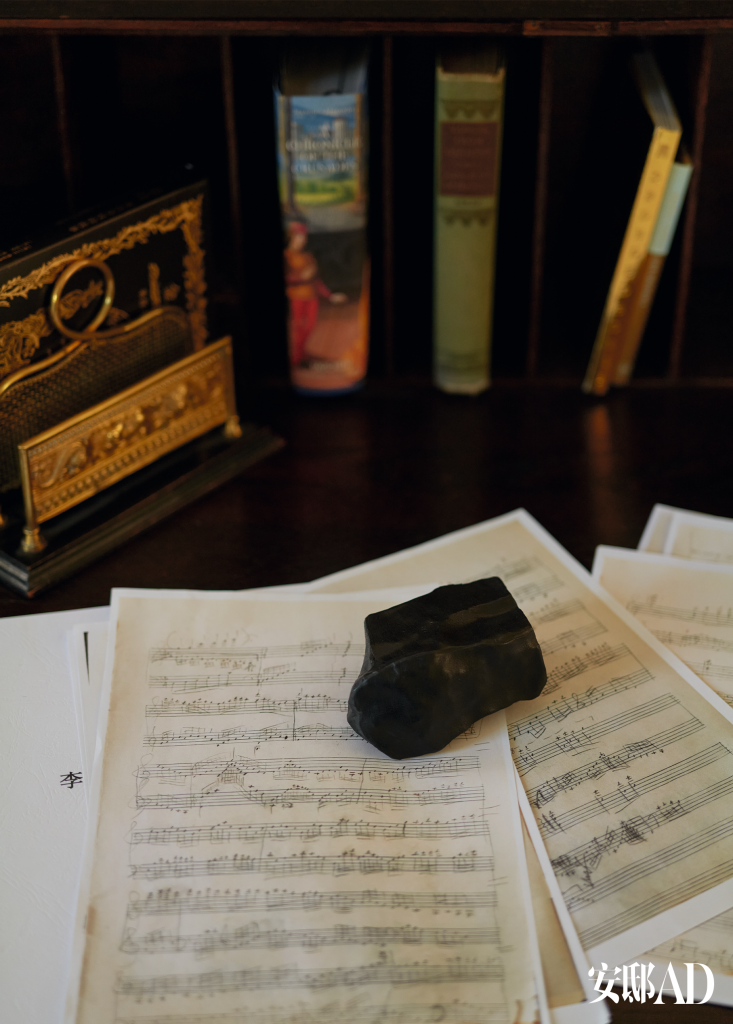
Musical notes are the language of musicians, and these manuscripts are Muye Wu’s way of speaking to the world. The 1960s British brass envelope holder, black paperweight, and books are from AMBELIE.
One afternoon in Hangzhou, Muye Wu translated it all onto the piano keys with his fingers. At that moment, the sunlight pierced through the curtains and onto his face, causing him to instinctively turn his head to avoid it. “I’m a little afraid of direct sunlight,” he said, giving us a close-up view of the profile only a concert audience would usually be able to admire from afar. Two hundred years ago, it was Liszt, also known for his near-perfect profile, who changed the custom of playing with his back to the audience, choosing instead to play side-on. But this same celebrity, already wildly popular at the time, had once referred to the then-obscure Chopin as a “Prince” in his own salon.
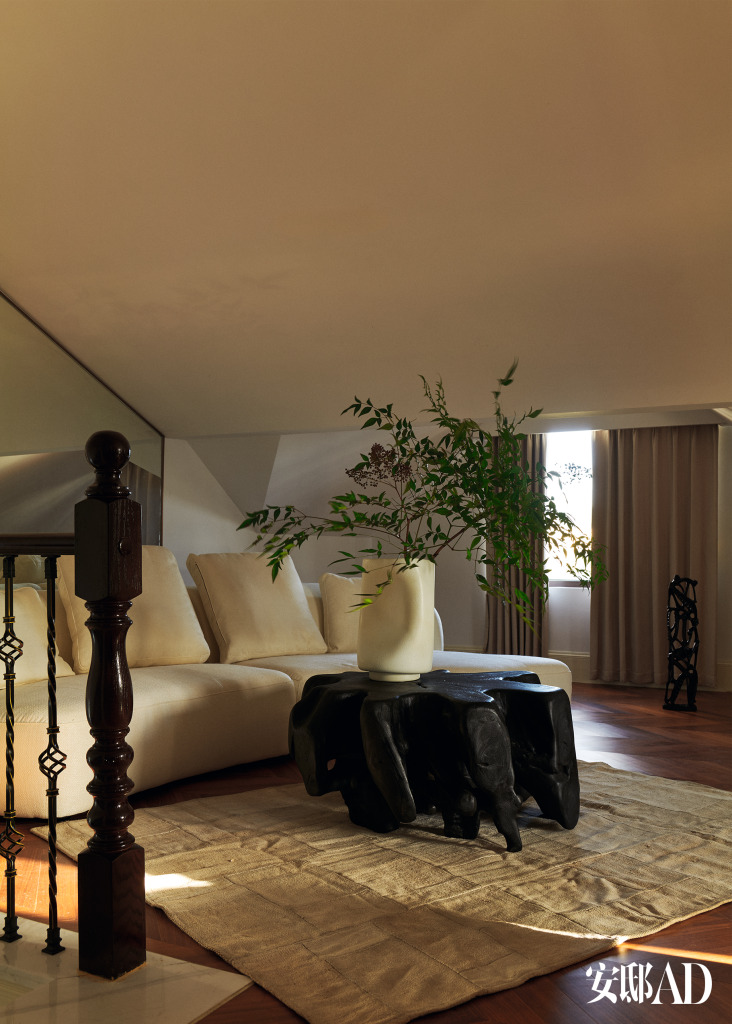
The attic’s structure creates a cozy atmosphere, with a hand-stitched wool rug and a black teak coffee table from YIJI COLLECTION, a white ceramic vase from For.D, and African antique wood carvings from AMBELIE.
In his two albums Monologues of the Strong, Muye Wu pays tribute to Beethoven and Liszt. These two giants, connected by Czerny as their grand-teacher and grand-student, are universally recognized in music history as possessing great hearts and great souls, capable of knocking on the gates of fate and the gates of hell. Does Muye Wu’s choice reflect his own inner voice as a strong man? He hesitates for a few seconds and doesn’t answer. But at least, he isn’t the type to be scared to tears by long shadows in a church, right? “But you have to understand why Chopin cried. If you’ve read his diaries and looked at his manuscripts, you’ll know there are very subtle layers and reasons behind it.” This time, he quickly spoke in defense of the Polish prince.
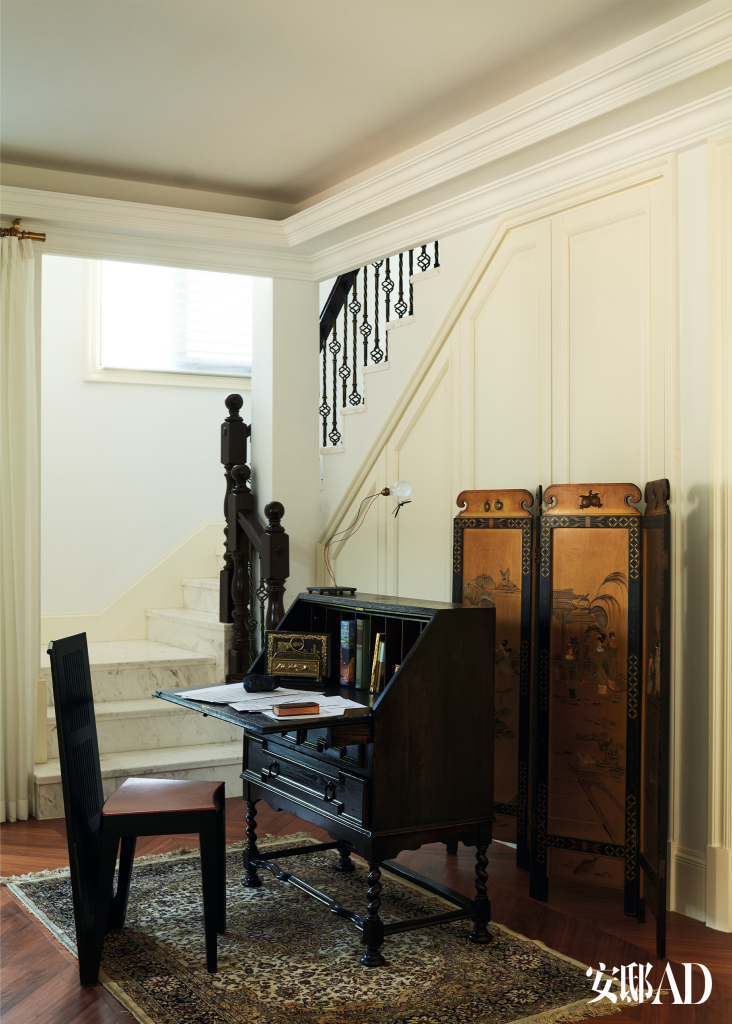
Italian Cassina Andrea Branzi “Model Lubekka” antique dining chairs, a British antique oak drawer desk, a four-panel yellow screen inlaid with jade depicting a 20th-century scene of ladies in a garden, and an antique rug are all from AMBELIE.
Perhaps it’s simply a question that’s hard to answer: like the thrill of collecting cold weapons, and yet during his student days, using his limited savings to buy expensive puppets from a workshop in Venice. Raising two imposing and agile hunting dogs, yet in private engaging in indulgent conversations with them. Loving everything with dark undertones, but always having his mood lifted by a touch of green from the plants on the coffee table. Fascinated by mechanics and parts, while equally absorbed in the art of playing with walnut artifacts. When faced with Liszt’s powerful voice, he lets “the hand and piano keys connect like a human-machine interface,” but when listening to Chopin’s dreamy murmurs, he will truly struggle. This constant tug between rationality and sensibility, spanning both art and life, forms what Muye Wu repeatedly emphasizes as his “contrast.”
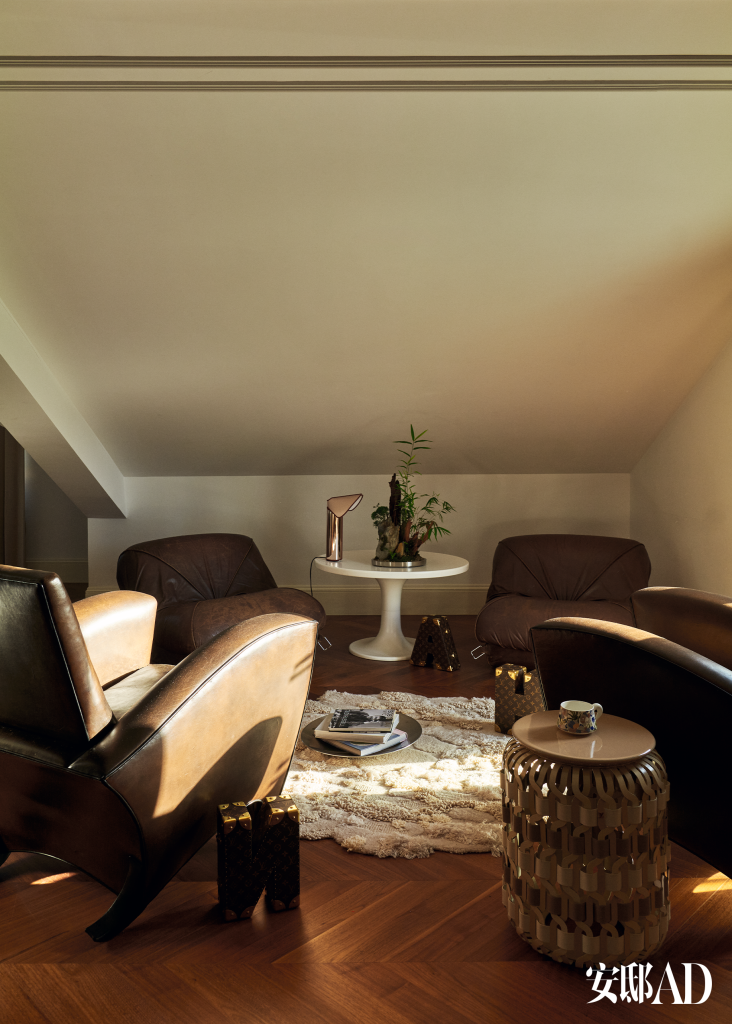
A monogram suitcase from Louis Vuitton’s Hard-Sided collection; a stainless steel metal tray from B&B; the CHIARA table lamp from FLOS, from For.D; the Patate sofa and side table from YIJI COLLECTION; and a green ecological bonsai titled Zhejiang Mountain Mixed Forest by Huang Shuo.
“Music is really a storm of thoughts, philosophy, humanity, love… all these things combined. It can only be felt.” Fortunately for Muye Wu, he has had this feeling from a young age. But behind this intuitive sensation lies “countless rationality to support it.” He magnifies past experiences infinitely, revisiting them within the philosophical framework he admires, like building a house, constructing his understanding piece by piece. He believes that when he returns to perform the same music again, his personality has been elevated through repeated purification. For him, art has never been something merely to enjoy. “It ultimately needs to be given back,” he describes it as if a silkworm spinning its cocoon. “If in the end, you need to spin something out, that’s another matter entirely.” For this reason, he has had to cut through numerous temptations from an early age, choosing only a sip from the fountain; needing to focus in an explosion of information to find his own unique path; and after each rebellious departure, find his way back again.
In entering music, “you have to learn to let go early.” Because music is creation, and creation requires the breath of endless energy and opportunities—it is an act of inhaling and exhaling, full of reflection and time. But you must never forget what moved you in the beginning, never forget the heart you started with. That initial emotional spark is the most precious—this time, he is resolute.
Chapter 3: Always on the Verge of Tears
Music and nature are Muye Wu’s passions, so the kitchen and dining areas are not the spaces he frequents most. Nevertheless, he tries to maintain a daily habit of making breakfast. In this setting, Muye Wu is dressed in a green corduroy embroidered shirt, pants, and black loafers, all from Louis Vuitton. A white wave-patterned vase, silver pitcher and cups, white plates, and a black shadow-patterned rug are from For.D. The dining area is adorned with a 20th-century lacquered screen featuring cranes and birds, with inlaid treasures on a dark green base, from AMBELIE.
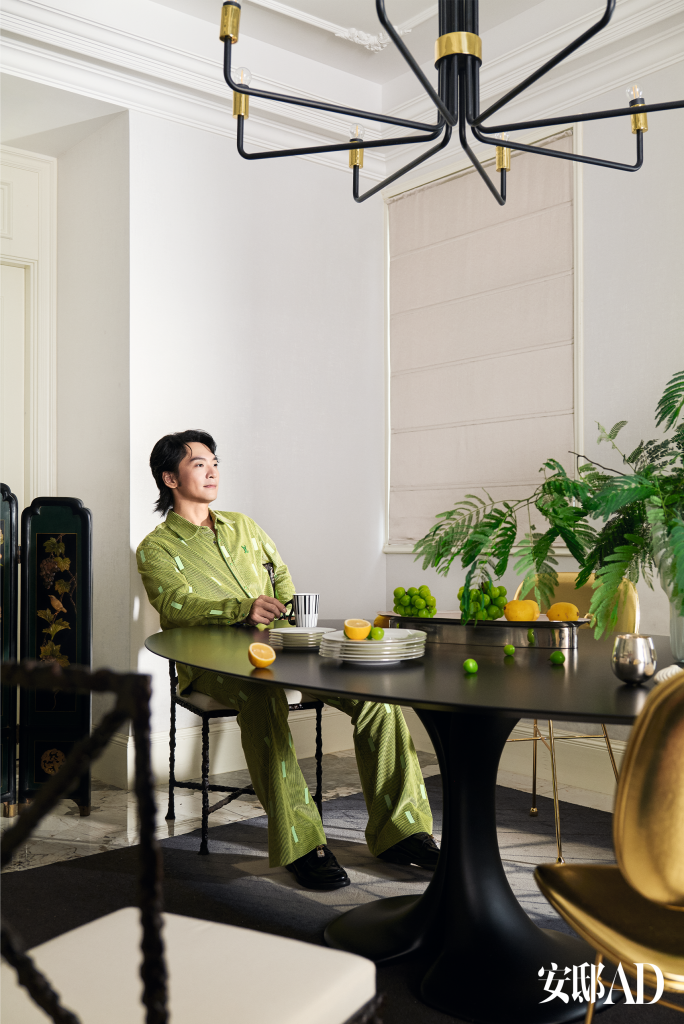
The choice of dining furniture also reflects Muye Wu’s love for “dramatic contrasts,” with a deep black metal dining table paired with cushioned dining chairs wrapped in metal and leather, providing a striking contrast both visually and texturally.
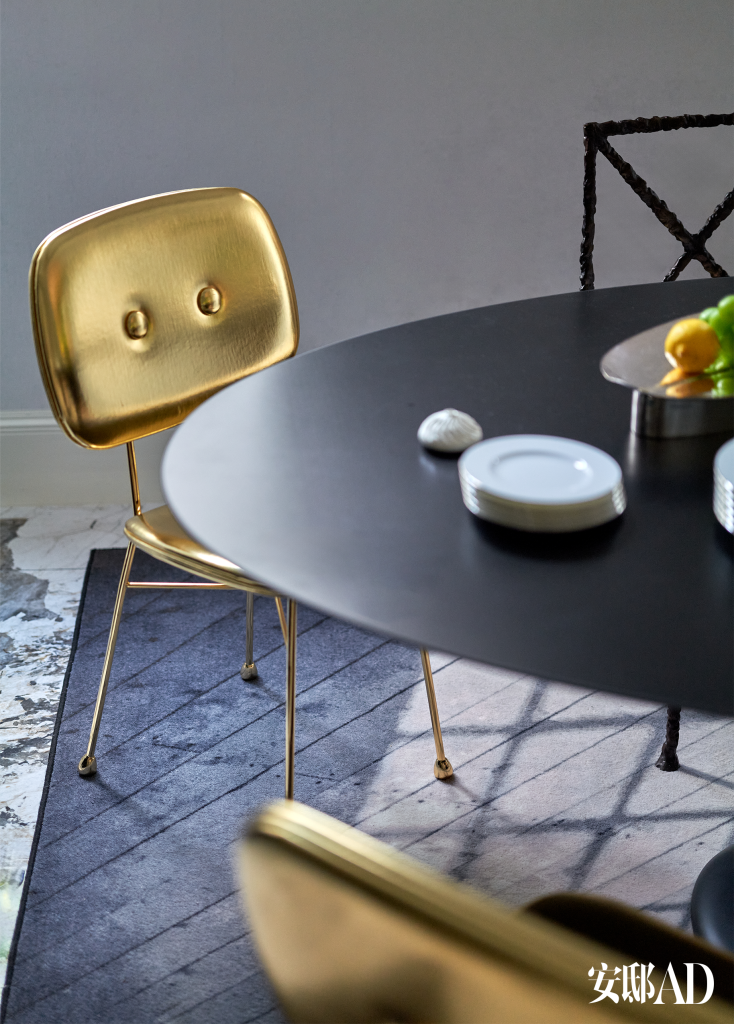
In life, Muye Wu devotes most of his time to the city and to the spotlight. Like the great musicians before him centuries ago, Muye Wu, accustomed to long hours of practicing, performing, and socializing, still longs for nature during his rare moments of free time. Whether it’s walking his dogs on the small hill behind his house each evening or taking a solo road trip with his two dogs to the mountains and streams to clear his mind, he views these moments as his personal journey. Since becoming a musician, he has been a busy traveler, much like Mozart, Liszt, Rubinstein, or Argerich. They were all destined to carry the expectations of fans around the world, circling the globe to deliver the most beautiful performances.
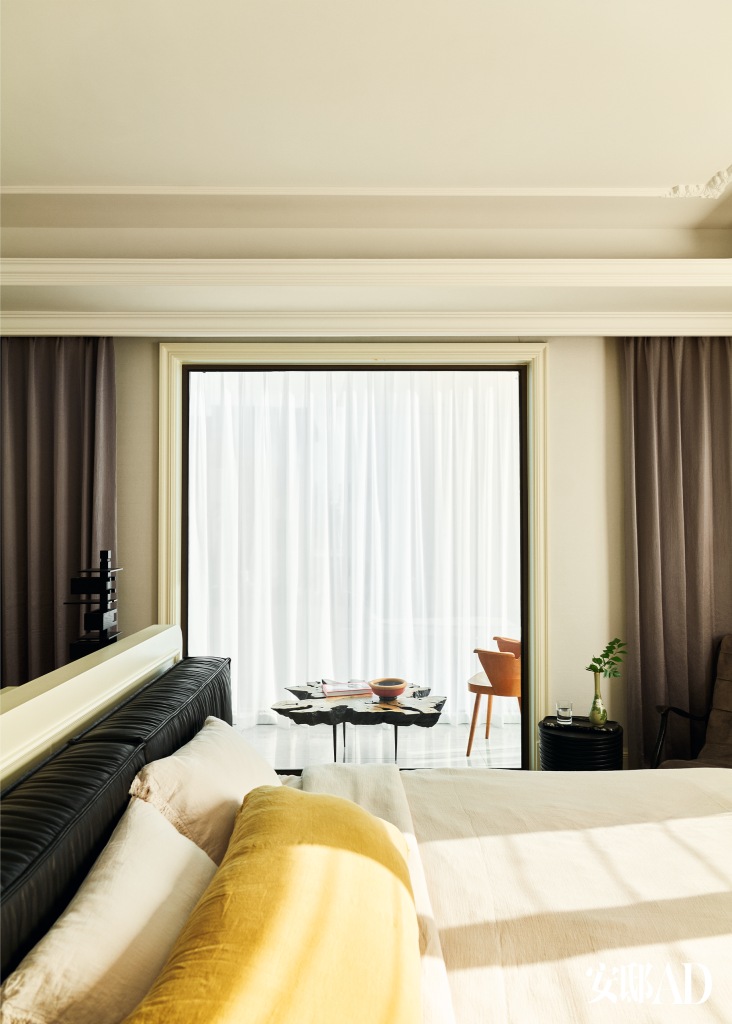
Muye Wu’s bedroom has an indoor balcony where he often reads and reflects. The bedding, pillows, bed, tree-shaped coffee table, and vintage wooden chair are from YIJI COLLECTION. A black architectural table lamp and a slender-necked vase are from AMBELIE. A ceramic bowl is from Poltrona Frau, and a Bottega Veneta glass is from For.D. Decorations and aromatherapy are also from For.D, and the leather spiral table lamp is from Louis Vuitton’s Objets Nomades travel home collection.
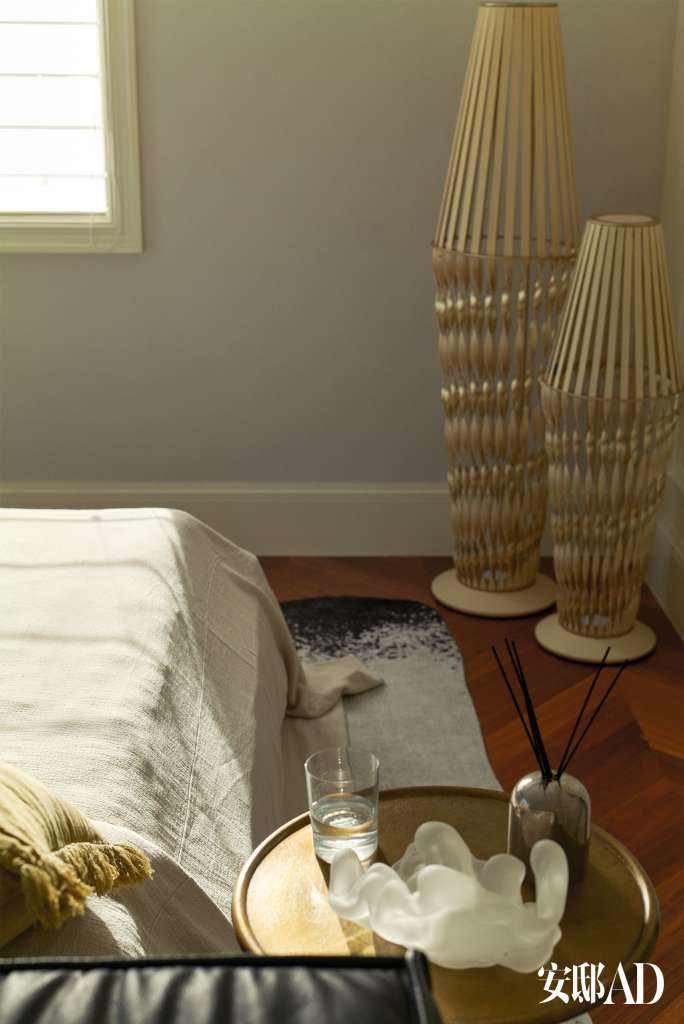
Muye Wu also travels between Europe and China, and from Shandong to Hainan. Carrying with him the memory of the last breath of nature he heard, moving from one city to another, stepping into one dazzling spotlight after another. Yet when he settles into that circle of light, he instinctively adjusts himself to a certain state. “Each time is special—whether it’s in front of millions or alone, what I’m thinking about is equally vast.” Only when this thought is grand enough can the number of people cease to matter. “Because when my fingers touch the piano keys, I’ve touched something real. In the end, it’s always just me and the piano, and that resonance and entanglement are enough to surpass any external force.” He slightly closes his eyes, then opens them, just as he does on stage. When he emerges from the beauty and pain of various composers by splitting, transforming, performing, and expressing, does he feel a sense of loneliness before the thousands of eager, expectant faces watching him?
The Pianist’s Journey Across Cities
A pianist is destined to shuttle between cities for tours. After exhausting his energy and strength under the spotlight, he needs to return home to take long walks…

Whenever Muye Wu is home, he takes his beloved pets, Huanhuan and Baobao, for walks in the nearby mountains every day. He wears a washed denim bow-tie shirt and deep olive-green cargo pants, both from LOEWE.
A pianist’s life is like this—extremely close to the audience, yet extremely distant. The closer one gets to music, could it also give rise to a fear? Just like all the pianos that have left a lasting impression on him—those French pianos from the 1920s, those ancient instruments where his fingers seem to connect spiritually with the keys—”None of them are mine.” Musicians are destined to live in the distance, and that’s when they must return home, leaving only curiosity for their fans.
In fact, like the pianist played by Ingrid Bergman in Autumn Sonata, who lies on the floor to talk with her daughter, when Muye Wu isn’t playing the piano, he often needs to truly relax. “That’s why I like sofas with good support and a sense of embrace.” Though this sounds like a joke, after long tours, his energy and stamina are nearly depleted. He desperately needs ample downtime and a sofa that feels like a hug, to help him slowly recover and step out of the stage’s spotlight.
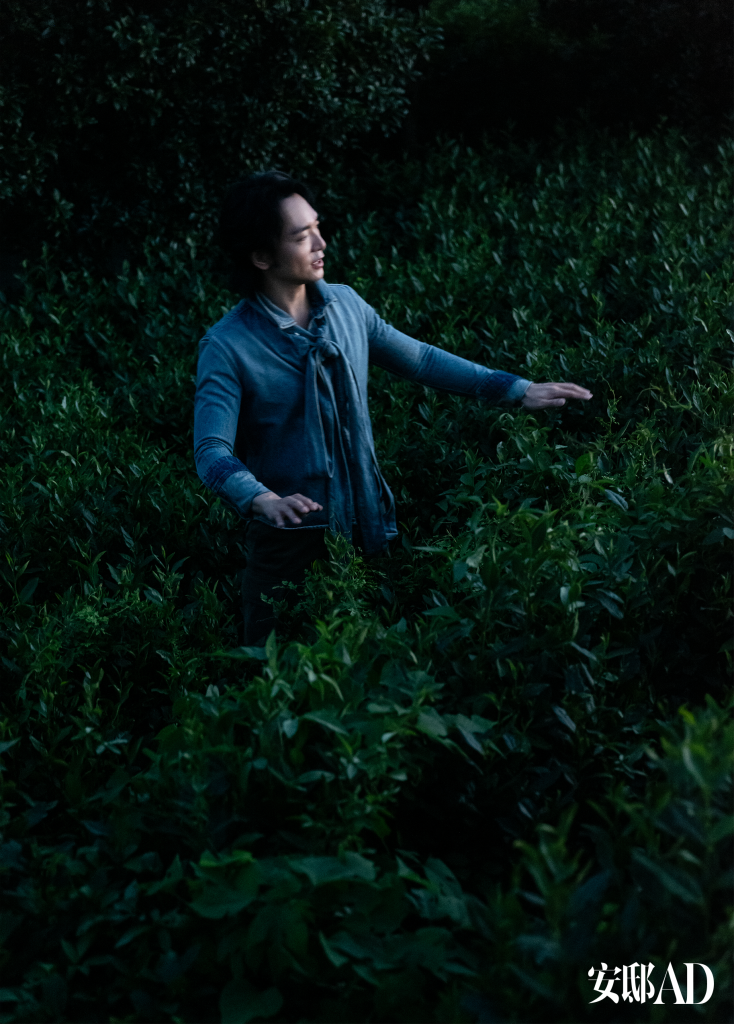
In Muye Wu’s perception, Hangzhou represents layers of green, a color unique to China—the hues of emerald, jade, teal, and his green.
Yet Muye Wu dares not truly immerse himself in comfort. The fate of an artist is to endure lifelong suffering. Beethoven, deaf, played the knocks of fate; Chopin, coughing blood, echoed the cold rain against the window ledge; Blind Abing, trapped in dual darkness of sight and life, finally glimpsed the bright moon reflected in a spring… “Great works of art are mostly born out of suffering and hardship. Artists are destined to struggle against comfort for their entire lives.” This is also why he constantly seeks contrasts.
He goes back and forth in time and space—Beijing, Shanghai, Hainan, Hangzhou, Shandong, Paris—always driving between different cities, between different homes. Changing places helps him re-enter a new environment and feel new sensations. This is his way of “deliberately maintaining pain.” Perhaps even as he calmly answers our questions, the ultimate dilemma of Faust still lingers in his mind. Or when his mental anguish, finger speed, and strength reach that critical point, Liszt and Chopin might descend between his fingers and the keys, granting him a fleeting moment of madness, danger, and extreme beauty. For a performer, that moment is eternity.
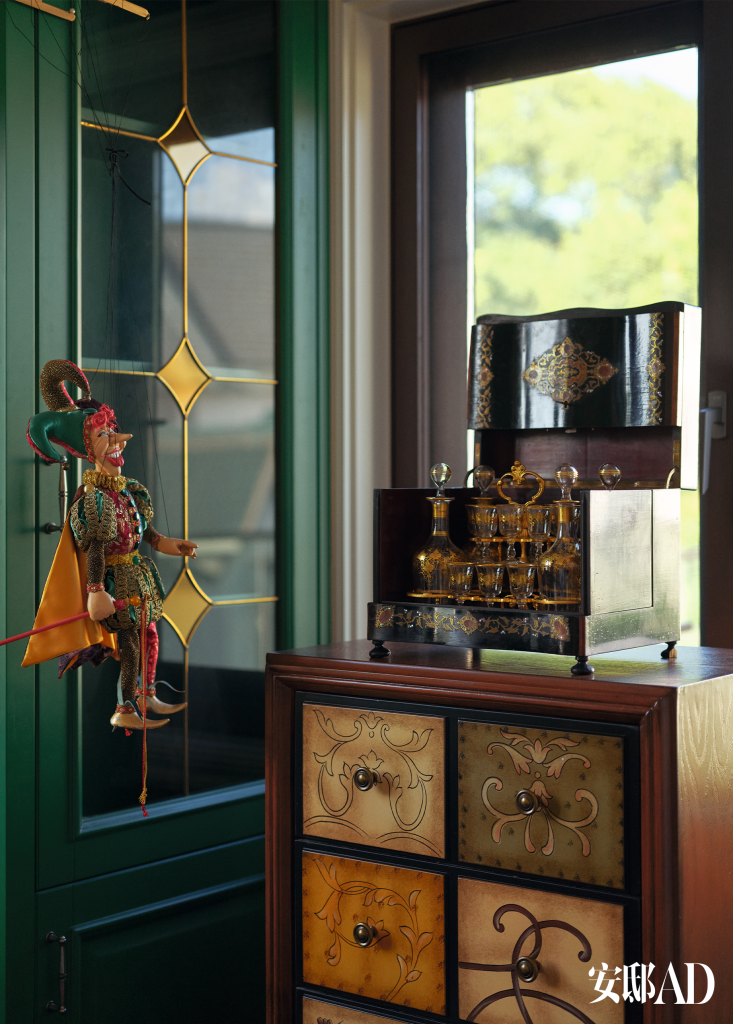
Having lived in France for many years when he was young, Muye Wu has many stories and collections from Europe, like the puppet he happened to buy in Venice, which has stayed with him for years.
Then Muye Wu must once again return home, take long walks, and discern the shades of emerald, jade, teal, and his beloved green… After moving to Hangzhou, he also gained a new method of meditation: “I began studying tea ceremony.” He found that its language, much like music, can be expressed independently, outside of logic. Just as he abstracted the beautiful moments from Tang Xianzu’s The Peony Pavilion and Ravel’s The Fairy Garden into his work Fate. “It’s like unfolding a scroll where birds chirp, streams murmur, and within it, there are people, stories, and so much love.”
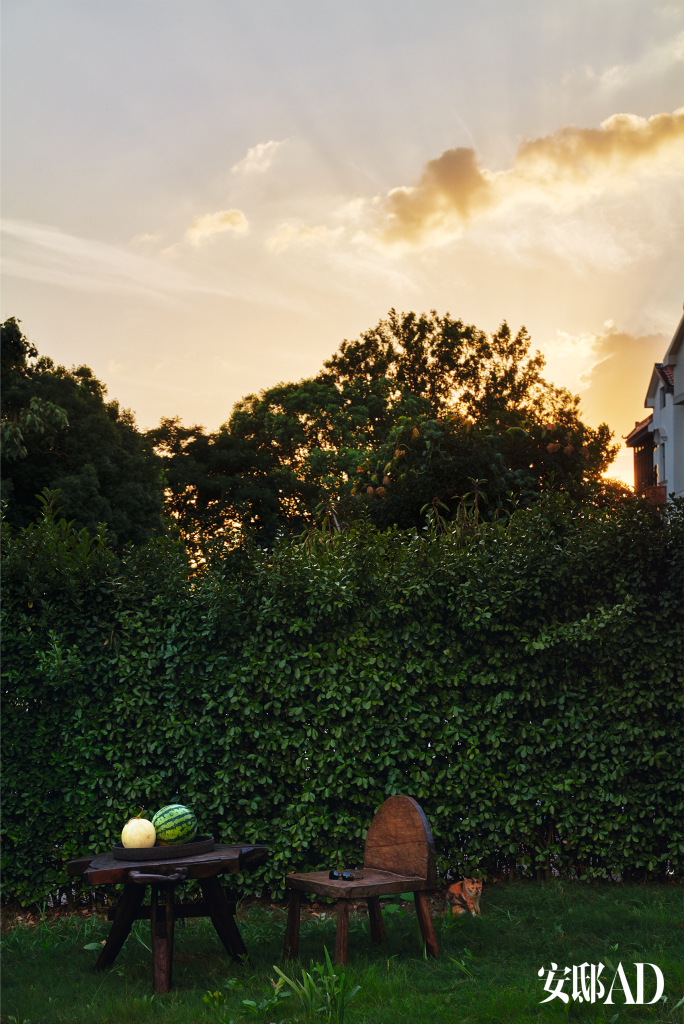
The view of the sunset from his courtyard in Hangzhou, with golden light shining behind the clouds, brings him closer to nature, which is one of the main reasons he moved there. Black ceramic plates are from Baxter, provided by For.D. Handmade wooden tables and chairs are from YIJI COLLECTION.
Can the Daoist recluse Qingyuan from the Ming Dynasty converse with the impressionist Maurice Ravel? In Chinese or French? Muye Wu shakes his head: “Different languages, but the stories they tell are the same.” He believes they would surely smile at each other. Quietly, before bed each night, he pulls open and closes the drawers of the cello-shaped cabinet in his living room, just as he would gently close a musical score in his mind. At that moment, “the feeling that rises within me is that of the green I found, the green that belongs to China.” That green is the “traveler beyond the spring mountains” green, the “drizzling evening rain across the rivers and skies” green, a green entirely different from Liszt and Chopin’s—a green that allows him to temporarily forget the storm ahead and quietly admire the beauty of the momentary moon.
